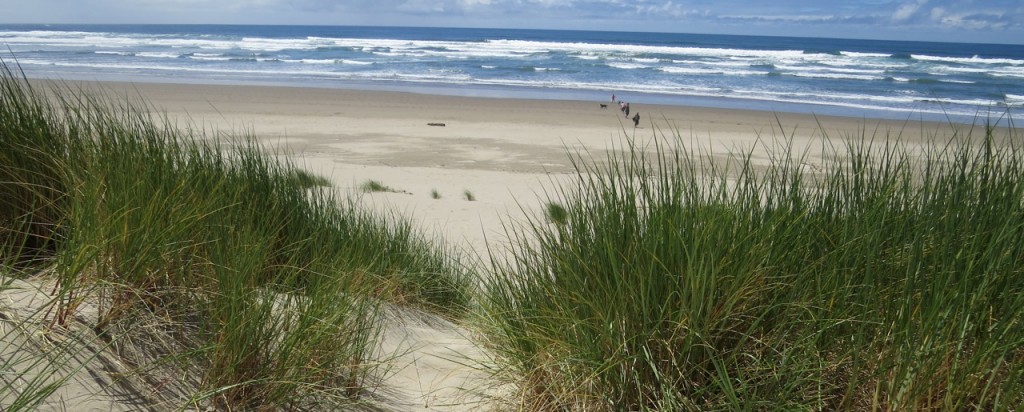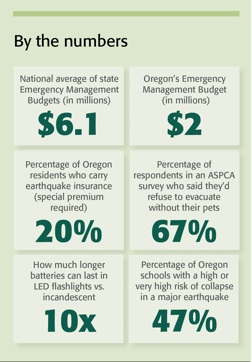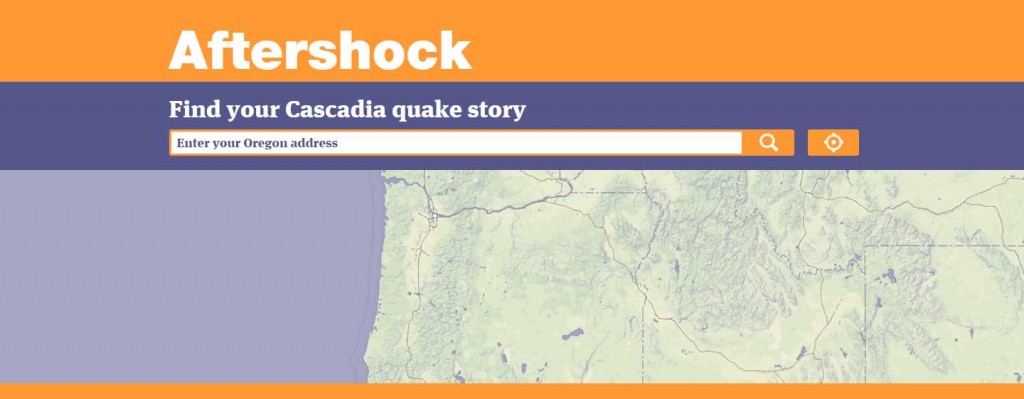Oregon lags in preparedness and the consequences could be dire
Many of you have heard about it. Some of you may have even seen it. The elephant … sitting quietly … in the corner of the room.
The elephant is, of course, just a metaphor. A metaphor for one of the largest, most powerful events on the planet: a Cascadia Subduction Zone earthquake and tsunami. It is now common knowledge that much of Oregon’s breathtaking beauty — from the rugged coastline of the Pacific to the jagged peaks of the Cascades — is born out of these awesome, perfectly natural, geologic events.

The most recent subduction zone earthquake and tsunami occurred off the coast of Japan on March 11, 2011. The fifth-largest earthquake recorded in modern times, it moved Japan’s main island of Honshu eastward by eight feet, displaced trillions of tons of seawater, resulting in a devastating tsunami, and literally shifted the earth on its axis. The event also exacted major human, economic and environmental costs: 18,000 deaths, $200 billion in damage and the meltdown of a nuclear power plant. All of this in the most earthquake- and tsunami-prepared country in the world.
Like Japan, Oregon and the Pacific Northwest will experience a major earthquake and tsunami in the future. We don’t know when it will strike. We don’t know how big it will be. But we know it is coming. And like the elephant in the room, we can little afford to ignore it.
 What is Oregon doing to prepare?
What is Oregon doing to prepare?
Thankfully, subduction zone earthquakes don’t happen very often in Oregon. The last one occurred 105 years before Lewis and Clark ever set eyes on the Pacific. It was January 26, 1700 — a time when native stories told of the ground shaking and the waters rising. A time when Oregon was much more resilient than today.
There were no bridges to shake apart. No schools, hospitals or fire stations located where the tsunami could swallow them up. And no cities full of people dependent on basic goods and services provided by a global economy. The 1700 earthquake and tsunami was an epic event. But it was not a disaster.
By comparison, it is very easy to paint a grim picture of Oregon’s state of resilience today. In February of 2013, the Oregon Seismic Safety Policy Advisory Council (OSSPAC) told members of the Legislative Assembly that: “Available studies estimate fatalities ranging from 1,250 to more than 10,000 due to the combined effects of earthquake and tsunami, tens of thousands of buildings destroyed or damaged so extensively that they will require months to years of repair, tens of thousands of displaced households, more than $30 billion in direct and indirect economic losses (close to one-fifth of Oregon’s gross state product), and more than one million dump truck loads of debris.”
Numerous vulnerabilities exist across a wide range of sectors: business, housing, energy, education, water, wastewater, transportation, critical facilities, communication, public health, food and more. The main conclusion from OSSPAC’s study: “Resilience gaps of this magnitude reveal a harsh truth: a policy of business as usual implies a post-earthquake future that could consist of decades of economic and population decline — in effect, a ‘lost generation’ that will devastate our state and ripple beyond Oregon to affect the regional and national economy.”
Anyone who knows me well would tell you I can be a cynic at times. On those days when cynicism takes hold, I fear that Oregon is perilously under-prepared for a Cascadia Subduction Zone earthquake and tsunami event. And I am not alone. Scott Ashford, chair of the Oregon Resilience Task Force and director of the Cascadia Lifelines Program at Oregon State University recently said, “Compared to the level of earthquake preparedness even in California and Washington, it’s clear that Oregon is bringing up the rear.”
Consider these facts
The Oregon Military Department’s Office of Emergency Management has half the staff (39) that Washington has (84). Only 20% of Oregon residents carry earthquake insurance.
It’s estimated that 47% of Oregon schools have a high or very high risk of collapse in a major earthquake — 75% of them were constructed before modern building code standards were adopted.
The national average of state Emergency Management Budgets is $6.1 million. Washington state’s budget is $3.8 million. Oregon’s budget is $2 million.
The good news is that OSSPAC also has a plan. The Oregon Resilience Plan outlines a set of strategies that over a 50-year time frame would dramatically increase Oregon’s ability to bounce back from a catastrophic earthquake and tsunami. As an added bonus, benefits from this effort will extend across a wide range of other natural and manmade hazards.
In response to OSSPAC’s plan, the Legislature passed Oregon Senate Bill 33. The bill establishes a Resilience Task Force with a specific charge to “implement the strategic vision and road map contained in the Oregon Resilience Plan.” The group held its first meeting in November. It has one year to deliver an implementation plan.
Resilience: Oregon’s New Investment Strategy
Resilience won’t just happen overnight. The Oregon Resilience Plan proposes 50 years of new capital investment, policy changes and incentives for individuals and businesses — bite-sized investments made over time that will pay dividends now and into the future.
Imagine the jobs we will create by investing in seismic upgrades to bridges, rebuilding our already crumbling schools and modernizing our utility infrastructure. Imagine the social benefits we will gain as community members come together to map their neighborhoods, taking stock of the things in their homes and garages that they will use to help each other after the quake. Imagine the parks, open spaces and natural amenities we will restore when hospitals and homes, businesses and infrastructure are relocated outside hazard zones. Imagine the tourists that will come to walk and bike on the paths we’ve built to serve as evacuation routes for when that fateful day comes.
Imagine the benefits in your community, not after the earthquake, but today. The environmental, social and yes, economic dividends that come when communities invest in resilience. It is not a risk-free path. First, we must choose to plan for a low-chance, high-impact event that may not happen in our lifetime.
Remember the elephant? I hope you’re hungry. Because it is past time we started eating it. One bite at a time.
View the Plan >>>
Reprinted with permission from Community Vitality, Spring 2014, © 2014 The Ford Family Foundation. For the full Community Vitality edition of “The Time to Prepare”, visit http://www.community-vitality.org/Spring2014TimeToPrepare.html
 About the Author: Josh Bruce is the interim director of the Oregon Partnership for Disaster Resilience (OPDR), a program of the Community Service Center at the University of Oregon. He has assisted communities throughout Oregon with a variety of natural‐hazard mitigation and recovery planning projects.
About the Author: Josh Bruce is the interim director of the Oregon Partnership for Disaster Resilience (OPDR), a program of the Community Service Center at the University of Oregon. He has assisted communities throughout Oregon with a variety of natural‐hazard mitigation and recovery planning projects.
 About the Author: Geoff Ostrove was instrumental in helping to gather data for this project and connecting the team to subject area experts. Currently finishing his PhD in Media Studies, Geoff received his MCRP from PPPM in 2013 and is working with the Oregon Infrastructure Finance Authority’s Seismic Rehabilitation Grant Program as the Oregon Sea Grant’s Natural Resources Policy Fellow. For more information about what Geoff is up to these days, check out his blog at http://blogs.oregonstate.edu/seagrantscholars/author/sea_ost/.
About the Author: Geoff Ostrove was instrumental in helping to gather data for this project and connecting the team to subject area experts. Currently finishing his PhD in Media Studies, Geoff received his MCRP from PPPM in 2013 and is working with the Oregon Infrastructure Finance Authority’s Seismic Rehabilitation Grant Program as the Oregon Sea Grant’s Natural Resources Policy Fellow. For more information about what Geoff is up to these days, check out his blog at http://blogs.oregonstate.edu/seagrantscholars/author/sea_ost/.



